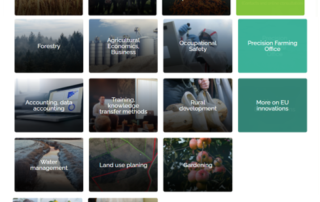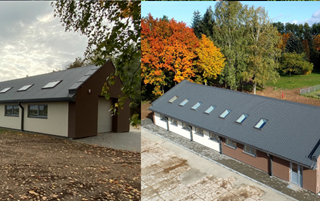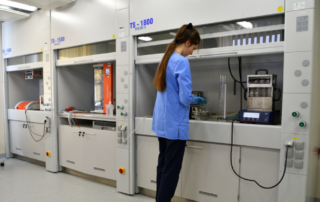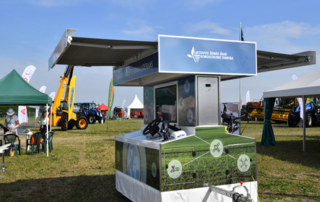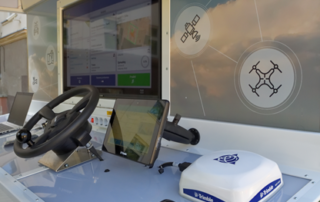What was the challenge/ problem that was addressed? Why is it important for the partnership to solve the problem?
Linear innovations are being replaced by interactive ones which means the key aspect in the process of development of innovations is co-operation among different actors from various fields (farmers, foresters, advisors, researchers, representatives from business). The current situation of transfer of knowledge in Europe and other countries as well as the situation in Lithuania were analyzed and it was revealed that there was a need for improvement and development of the system of knowledge transfer in Lithuania. There was a need for strengthening of co-operation among Lithuanian agricultural research and study institutions and farmers and a need for improvement of coordination of development of agricultural innovations, their use, and dissemination of the results. There was also a need for expansion of the scale of modern agricultural services and infrastructure for testing, demonstration, and dissemination of innovations as well as to ensure integration of experimental training farms into the system of knowledge transfer. The success of the development of innovations greatly depends on how effective the system of knowledge accumulation and transfer is.
How did you solve the problem? (Or if your practical case is still in progress how are you solving the problem?)
EIP operational group members of which were Lithuanian agricultural research and study institutions, advisory institutions, and experimental training farms was formed to implement a project the aim of which was to develop a system of accumulation and transfer of agricultural knowledge. Members of the EIP operational group had experience in animal husbandry, plant production, gardening, horticulture, environmental protection, and other fields. The aim of this group was to quickly, precisely, and transparently implement all processes of development of innovation, its demonstration, and dissemination within a project establishing a relation between research and practice and ensuring faster and more effective use of innovations in practice.
What is innovative in your practical case? (e.g. technological innovation, new product or services, market innovations, social/organizational innovations etc.)
A new, atypical innovation, i.e. organizational innovation was suggested by the operational group. A large number of partners was involved in project activities. In total, 18 parties contributed to the implementation of the project.
One of the results of the project was the establishment of center “Innovation Gates” consisting of Innovation Support Service, Information System of Applied Innovation Research and Results (TITRIS), and Centre of Services of Precision Farming where unbiased services of precision farming were provided and training were organized.
In addition, a pavilion for demonstration of technologies was built where innovative technologies and principles of their operation were demonstrated and compatibility of innovative technologies with machinery owned by farmers were specified. Various training were organized as well.
Technical equipment was purchased by project partners. Then, the equipment was tested in natural production conditions on every farm. Research on the effectiveness of technological equipment purchased was carried out and reports on the results of the research were prepared. The results are available in TITRIS (https://titris.lzukt.lt/en/general/defaultAction/).
A training program of precision farming was prepared and theoretical and practical training for farmer groups was organized.
A methodology of dissemination of results of applied innovation research was prepared and tested in practice.
Recommendations for results of applied innovation research were made.
A methodology of inter-institutional co-operation was prepared.
Research on competencies of experimental farms to apply agricultural innovations in the process of production was carried out.
A network of experimental farms was formed.
A simulation display of precision farming was purchased which was used to show farmers the full cycle of precision farming and encourage them to use innovative technologies on their farms.
A laboratory was established in 2019. Soil samples taken from customers’ farms as well as water, sewage, manure, and other samples were analyzed in the laboratory.
What are the success factors in solving the problem?
The project was successful because project partners had the same purpose and were highly concentrated at meeting the project objectives. All the parties were willing to test innovative technologies and evaluate their effectiveness on farms. Partners strictly followed all recommendations on installment and operation of technical devices. All the parties were willing to co-operate. The wide experience of specialists of LAAS in making and submitting tenders and leading projects was one of the key factors in the successful implementation of the project.
Lessons learned
Working in co-operation with partners from different fields always is a challenge. Experimental farms, researchers, and advisors worked together to achieve the main objectives of the project. Reasoned discussions among partners led to rational collective decisions. Project partners willingly shared their experience which was one of the key factors of the success of the project.
What role does the advisor or advisory service play within the practical case?
Innovation Gates was a multi-actor project. Lithuanian Agricultural Advisory Service (LAAS) was a lead partner responsible for the process of preparing and submitting the tender as well as coordination of project activities. LAAS is an advisory institution therefore, specialists of it are in close relation with farmers and they are aware of problems farmers face as well as their needs. LAAS was responsible for the establishment of the center “Innovation Gates”, coordination of activities, and purchase of equipment. LAAS was also responsible for the foundation of the Centre of Precision Farming, the preparation of training programs, and the demonstration of innovative technologies. LAAS was responsible for the provision of advisory services about precision farming, training of farmers, and providing them information about possibilities of broadening their knowledge and skills in precision farming. LAAS played a key role in preparing the methodology of inter-institutional co-operation as it was responsible for writing part of the methodology about its own organization as well as for coordination of the process of gathering descriptions of the process of co-operation from project partners and preparing the final version of the methodology.
Can your approach be transferred and/or adapted for other innovation challenges and regions?
Yes
Please estimate transferability in a scale from 1 to 5
3
For sharing the experience on the good practice, please contact Rimtautas Petraitis rimtautas.petraitis@lzukt.lt
Link to the practice http://www.agroakademija.lt/Straipsniai/StraipPerziura?StraipsnisID=13327&TemaID=10
https://www.youtube.com/watch?v=5wMOBoyw3GI
